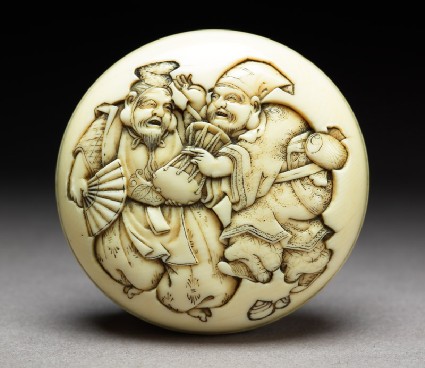Browse: 1146 objects
- Reference URL
Actions
Manjū netsuke depicting the gods Daikoku and Ebisu dressed as manzai dancers
-
Details
- Associated place
- Date
-
mid - late 19th century
Meiji Period (1868 - 1912)
- Artist/maker
-
Ikkōsai Kōjitsu (1833 - 1893)
- Material and technique
- ivory, lathe-turned, with carved decoration, and stained with pigment
- Dimensions
-
2.2 cm (height)
4.8 cm (diameter)
- Material index
-
organic › animal › tooth › mammal tooth › ivory
- Technique index
- Object type index
- No. of items
- 1
- Credit line
- Bequeathed by Dr Monica Barnett, 2001.
- Accession no.
- EA2001.100
-
Further reading
Impey, Oliver, and Joyce Seaman, Japanese Decorative Arts of the Meiji Period 1868-1912, Ashmolean Handbooks (Oxford: Ashmolean Museum, 2005), no. 52 on p. 108, illus. p. 109
Oxford: Ashmolean Museum, 23 April-22 September 2013, Manjū: Netsuke from the Collection of the Ashmolean Museum, Joyce Seaman, ed. (Oxford: Ashmolean Museum, 2013), no. 40 on pp. 106-108, illus. p. 109
Glossary (3)
Manjū, manzai, netsuke
-
Manjū
The manjū is a type of netsuke or toggle which takes its name from a round, sweet, bean paste-filled bun. A greater dynamism can often be achieved on the front and back of the netsuke than with other three-dimensional carving.
-
manzai
Manzai dancing originated in China and has been performed in Japan since the eighth century. Traditional manzai had two representatives from a shrine or temple. One of them played the ‘wit’ and the other the ‘straight man’.
-
netsuke
The netsuke is a form of toggle that was used to secure personal items suspended on cords from the kimono sash. These items included purses, medicine cases or tobacco paraphernalia.
Past Exhibition
see (1)-

Tales in the Round: Manjū Netsuke and Japanese Woodblock Prints
(from 30th Apr until 22nd Sep 2013)
Location
-
- currently in research collection
Objects are sometimes moved to a different location. Our object location data is usually updated on a monthly basis. Contact the Jameel Study Centre if you are planning to visit the museum to see a particular object on display, or would like to arrange an appointment to see an object in our reserve collections.
Publications online
-

Japanese Decorative Arts of the Meiji Period
Manjū netsuke with a lively design carved in sunken relief of two of the Seven Gods of Good Fortune (Shichifukujin) posing as street entertainers. Daikoku, his mallet tucked into his belt, beats a drum as Ebisu, fan in hand, dances to the rhythm.
Ikkosai Kōjitsu (1833-1893) specialised in the carving of ivory manjū netsuke, after joining the Hōjitsu School in Tōkyō. The great Ansei earthquake and fire in Tōkyō in 1854 destroyed large numbers of netsuke and in order to replace them in a less time-consuming way, a cirle of ivory was cut and the basic shape turned on a lathe. The carved decoration was then added by hand. Although the shape existed before, many of this type date from after the disaster. The name manjū refers to the shape of bean-cakes.
The Barnett bequest, of which this netsuke is representative, was given to the museum after the publication of Japanese Netsuke in Oxford in 1987.
© 2013 University of Oxford - Ashmolean Museum


